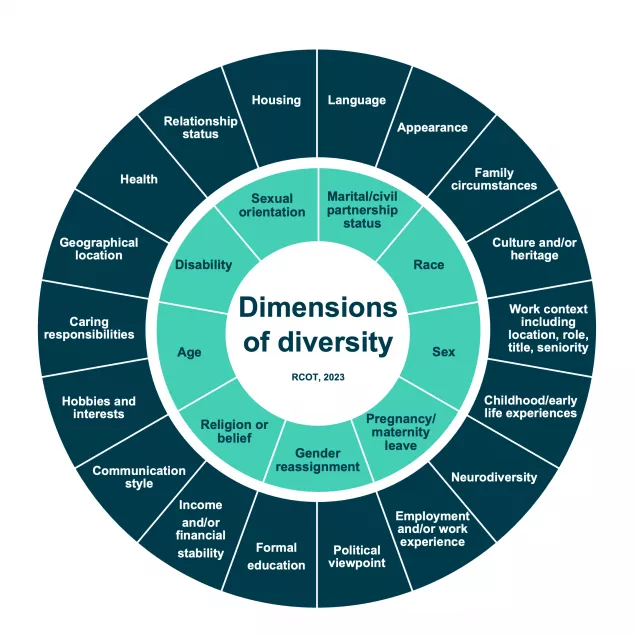EDB toolkit
EDB critical-self awareness interactive toolkit
In working through this toolkit, you'll cover aspects of critical reflection and self-assessment relating to equity, diversity and belonging (EDB), including the four stages of EDB competence.
We hope that through the use of the toolkit, you’ll have:
- Better awareness of your current level of EDB competence
- Improved understanding of the different dimensions of diversity
- Identified your next steps in translating that learning and awareness into action on your continuing EDB journey
- Considered how this toolkit supports you to meet the revised standard 5 within the standards of proficiency for occupational therapists.
1. Toolkit navigation
A document which outlines the different parts of this critical self-awareness toolkit
EDB Toolkit Navigation (PDF, 401.82KB)
2. EDB critical-self interactive toolkit
An evidence-informed toolkit which encourages self-reflection and supports you to identify where you are at on your EDB journey.
EDB Toolkit Interactive Toolkit (PDF, 2.68MB)
3. Reflection template
A space to record your reflections, learning and actions you plan to take to find out more and put learning into practice. You can save and upload this as evidence to your CPD portfolio, and it’s useful to re-visit your reflections at a later date to check back on progress made.
EDB Toolkit Reflection Template (PPTX, 2.3MB)
4. Diversity wheel
A visual image of the dimensions of diversity/ diversity wheel slide within the toolkit.

5. Prompt cards
Reflective questions to encourage discussion and reflection which can be used as a group activity.
Useful resources
We'll continue to add to this area with resources that you may find helpful. If you have any ideas for other things we should add, please contact Ketan Davé, [email protected]
If you need independant discrimination advice, contact the Equality and Human Rights Commission.
Equalities legislation
The Equality Act 2010 covers everyone in England, Scotland and Wales and protects people from discrimination (direct or indirect), harassment, and victimisation. It came into force on 1 October 2010. It brings together over 116 separate pieces of legislation into one single Act so that it is easier to use. Under the Act, there are nine protected characteristics: age, disability, gender reassignment, marriage and civil partnership, pregnancy and maternity, race, religion or belief, sex, sexual orientation. The Equality Act does not apply to Northern Ireland.
- Equality Act 2010 | EHRC (equalityhumanrights.com)
- Protected characteristics | EHRC (equalityhumanrights.com)
- Sex discrimination | EHRC (equalityhumanrights.com)
- Marriage and civil partnership discrimination | EHRC (equalityhumanrights.com)
- Sexual orientation discrimination | EHRC (equalityhumanrights.com)
- Race discrimination | EHRC (equalityhumanrights.com)
- Age discrimination | EHRC (equalityhumanrights.com)
- Pregnancy and maternity discrimination | EHRC (equalityhumanrights.com)
- Religion or belief discrimination | EHRC (equalityhumanrights.com)
- Disability discrimination | EHRC (equalityhumanrights.com)
- Gender reassignment discrimination | EHRC (equalityhumanrights.com)
- Direct and indirect discrimination | EHRC (equalityhumanrights.com)
- Harassment and victimisation | EHRC (equalityhumanrights.com)
- Terms used in the Equality Act | EHRC (equalityhumanrights.com)
- Equality Advisory and Support Service | EHRC (equalityhumanrights.com)
- Individuals | EHRC (equalityhumanrights.com)
- Public sector | EHRC (equalityhumanrights.com)
- Business | EHRC (equalityhumanrights.com)
In Northern Ireland, equality and anti-discrimination law is not consolidated into one single act. Equality areas are: age; disability; gender/sex (including trans); race; religious belief/political opinion; sexual orientation. There are several pieces of legislation covering the above equality areas, all underpinned by Section 75 of the Northern Ireland Act 1998